Filichia Features: The Most Happy Fella Makes Theatergoers Happy
Filichia Features: The Most Happy Fella Makes Theatergoers Happy
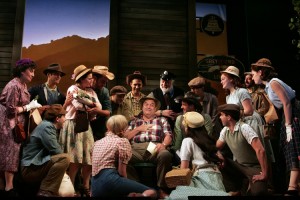 My heart is so full of admiration for John Payonk.
My heart is so full of admiration for John Payonk.
Last week, he rescued The Most Happy Fella at the Goodspeed Opera House in East Haddam, Connecticut.
Bill Nolte, who usually plays Tony -- the aging vintner who desperately wants to be a husband and father -- fell ill and couldn’t finish his Wednesday evening performance. Payonk went on for Act Two.
Nolte still wasn’t well enough for the Thursday matinee, which I caught. So I’d be seeing Payonk’s first full performance only 15 hours after his rescue operation.
He was letter-perfect, not to mention note-perfect and blocking-perfect, too. Yes, after Tony is injured, he must sit in a wheelchair for many scenes. But Payonk had to know where to roll that chair.
All right, it IS true that when you’re in a show, you wind up knowing everyone’s part, and Payonk has been part of The Most Happy Fella’s ensemble since rehearsals began in late summer and performances commenced on Sept. 20. Thus, he had plenty of time to learn the show from osmosis. But there’s a profound difference between knowing all the lines and songs and performing them.
Moral of the story: if you’re an understudy, you MUST be prepared to go on -- even if the performer assigned the role seems as invincible as Achilles from head to ankle.
Don’t forget, too, that Payonk was technically overtaxed, for, as The Most Happy Fella bookwriter, composer and lyricist Frank Loesser famously said of his 1956 hit, “It’s a musical with a lotta music.” Tony has six solos and appears in nine other numbers. When Payonk performed “Mamma, Mamma” – which ends with quite a long-held note – the audience was so impressed that it couldn’t wait for him to finish, but had to applaud while he still had a measure or so to go.
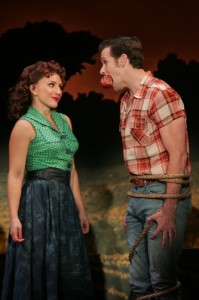 Many regard the show as a genuine opera, for some songs reach lofty heights not only for Tony, but also for Amy. She’s the young waitress whom Tony courts and calls Rosabella. Her role requires a soprano that must somehow be delicate and strong at the same time. Here Mamie Parris admirably scored in her six solos as well as in the five other numbers she shared, all the while conveying that this waitress had a little mileage on her.
Many regard the show as a genuine opera, for some songs reach lofty heights not only for Tony, but also for Amy. She’s the young waitress whom Tony courts and calls Rosabella. Her role requires a soprano that must somehow be delicate and strong at the same time. Here Mamie Parris admirably scored in her six solos as well as in the five other numbers she shared, all the while conveying that this waitress had a little mileage on her.
Loesser left room for more standard show songs. Joe, who’s Tony’s foreman, sings “Joey, Joey, Joey,” which starts out as a plaintive ballad and surges forward and upward. Little does he know that he’ll soon make his boss a cuckold. In fact, it happens on Tony and Amy’s wedding night – making for the quickest adultery in the history of musicals.
Well, it’s Tony’s own fault. He didn’t have the nerve to approach Amy when she was waiting on him, but left her a note and a little gift. That started a correspondence, and when she asked for a picture, he sent Joe’s instead of his own. The poor woman was led to believe that her admirer was young, trim and handsome instead of old, heavy and average-looking.
Here’s another instance when Payonk shone. Some weeks ago I mentioned the difficulty an actor encounters when he must just sit on stage and watch another performer do a solo. During "Joey, Joey, Joey" (beautifully sung by Doug Carpenter), Payonk paid attention to the lyrics and looked summarily embarrassed when Joe reported that he’d “had my fill of the ladies in the neighborhood." Once Joe sang that he was moving on, Payonk let us see the inner working of Tony’s mind as he hatched his plan to send Joe’s picture.
One might wonder why Tony doesn’t fear the day of reckoning when Amy will arrive at the vineyard. Yes, the stupid ruse and short-term solution would seem to confirm what his older sister Marie says: he’s a child at heart.
Many a Marie has been portrayed as humorless, even severe, and is often clad in a mournful black dress. Ann Arvia was far less of a pill and not as jealous as the Maries we usually see. Here director Rob Ruggiero wisely chose to stress that Marie is genuinely concerned about her brother’s welfare, and thinks he’s headed for ruin by even considering marriage with a much younger woman. And while Arvia conveyed that Marie feared not being needed any longer, she more dramatically showed that she had a limited scope of what possibilities life can bring. Credit to her and Ruggiero for a refreshing and valid change – which also allowed Arvia to enjoy dancing in the tambourine-tapping number “Spozalizio.”
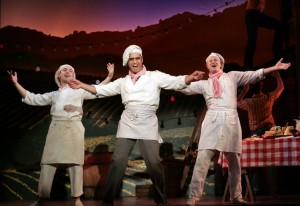 Eventually, Amy begins to forgive Tony, which leads to what must be the most charming of all musical theater charm songs: “Happy to Make Your Acquaintance.” Amy then comes to love Tony, but by then he’s so embarrassed by the age difference that he becomes paternal towards her. Payonk adopted the fatherly tone with ease, and Parris showed disappointment rather than irritation at his attitude towards her.
Eventually, Amy begins to forgive Tony, which leads to what must be the most charming of all musical theater charm songs: “Happy to Make Your Acquaintance.” Amy then comes to love Tony, but by then he’s so embarrassed by the age difference that he becomes paternal towards her. Payonk adopted the fatherly tone with ease, and Parris showed disappointment rather than irritation at his attitude towards her.
Eventually Tony gives himself over to ultimate pleasure, and that’s when The Most Happy Fella does what the best musicals do. Right after the most joyous moment comes the most devastating one: Amy is pregnant from that night with Joe.
Did we mention that the show takes place in an era before women were able to take, shall-we-say, precautions? If you didn’t know from the program that The Most Happy Fella was set in another time, you’d know from the sign in the diner that says root beer costs five cents.
The show was part of the era in which subsidiary lovers were written to provide sheer musical comedy entertainment. Cleo, Amy’s co-worker whom Tony later hires, soon hooks up with Herman, one of the vineyard’s rank-and-file employees. Once both discover that they’re from “Big D” (little “a,” double “l,” a-s), they start on the road to romance. Herman soon stops “Standing on the Corner” watching all the girls go by. Natalie Hill was able to make the all-too-experienced Cleo seem as if life were finally beginning now that she’d met the right man; Danny Lindgren made Herman seem just like that.
Lindgren was an understudy, too. Granted, he had more time to prepare, for Kevin Vortmann let management know in advance that needed to take a week off. But one would never know that Lindgren hadn’t been doing the show since Day One.
Moral of the story: if you’re an understudy, you MUST be prepared -- oh, wait, I already made that point, didn’t I? So what? It deserves to be stated at least twice.
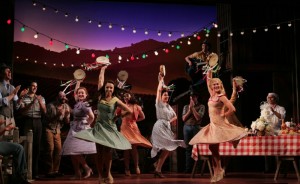 Because there’s so much music, Loesser was wise to give each performer ample time off to catch his breath and rest his pipes. Spelling the leads are three Neapolitan chefs who first sing about the glories of food and then get around to welcoming Amy, too. Martín Solá, Greg Roderick and Daniel Berryman made the crowd believe that Italian was their first language. Amy wasn’t the only one applauding wildly at number’s end.
Because there’s so much music, Loesser was wise to give each performer ample time off to catch his breath and rest his pipes. Spelling the leads are three Neapolitan chefs who first sing about the glories of food and then get around to welcoming Amy, too. Martín Solá, Greg Roderick and Daniel Berryman made the crowd believe that Italian was their first language. Amy wasn’t the only one applauding wildly at number’s end.
Does it all sound too daunting to perform? Yes, it is a big show, which is fitting for one that takes place in one of our biggest states (California) and references another (Texas). Frankly, Ruggiero made it all look easy, which is what the best directors are able to achieve. No, it’s clearly not a snap of a show, but remember: the greater the challenge, the more praise you get when you meet that challenge.
At first, The Most Happy Fella would seem to be a scenic challenge, too. The first scene is a diner that’s never seen again. But the rest of the show can pretty much take place on an outdoor unit set (here, nicely designed by Michael Schweikardt) that features a nice cyclorama of rolling hills and tilled farmland. At the welcoming party, the choice of lights on a string was not accidental; in honor of the Italian flag, they were red, white and green. The abbondanza of food was set on those trademark red-and-white checkered tablecloths sitting on planks of wood on sawhorses.
Hearty masculine voices are a must, too. They certainly stood out in “Standing on the Corner.” Choreographer Parker Esse had young women walking past, subtly but distinctly enjoying the attention that the randy men were giving them. One miss dared to express her interest to one lad who’d caught her eye, but then ran off nervously when all four guys came walking towards her.
And yet, for a big musical, it’s a very tender one. For once, the nice guy gets the girl. This May-December romance might turn out to be so successful for you that you’ll have to run it from at least May through December.
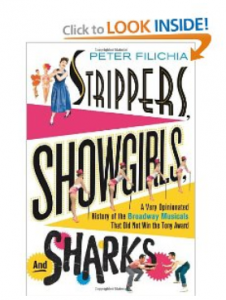 You may e-mail Peter at pfilichia@aol.com. Check out his weekly column each Tuesday at www.masterworksbroadway.com and each Friday at www.kritzerland.com. His new book, Strippers, Showgirls, and Sharks – a Very Opinionated History of the Broadway Musicals That Did Not Win the Tony Award is now available at www.amazon.com.
You may e-mail Peter at pfilichia@aol.com. Check out his weekly column each Tuesday at www.masterworksbroadway.com and each Friday at www.kritzerland.com. His new book, Strippers, Showgirls, and Sharks – a Very Opinionated History of the Broadway Musicals That Did Not Win the Tony Award is now available at www.amazon.com.

























